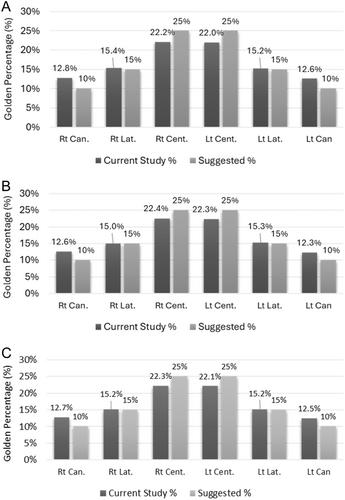Evaluation of the Golden Proportion, Golden Percentage, and Recurring Esthetic Dental Proportion in Kenyans of African Descent
Abstract
Objectives
To evaluate the validity of the Golden Proportion, Golden Percentage, and Recurring Esthetic Dental (RED) Proportion among Kenyans of African descent with naturally well-aligned teeth.
Materials and Methods
Standardized frontal photographic images of the smiles of 175 participants aged 18–35 years were obtained, and Adobe Photoshop was used to analyze and measure the frontal widths of the maxillary central and lateral incisors and canines in triplicate. The average teeth widths were calculated to determine the existence of the Golden Proportion, Golden Percentage, and RED Proportion, and their validity using independent sample t-tests to compare the differences in the mean teeth widths at α < 0.05.
Results
The number of male and female participants was 107 (61.1%) and 68 (38.9%), respectively. The Golden Proportion between the maxillary central and lateral incisors was found in 4.0% on the right and 2.8% on the left of all the participants, but between the maxillary lateral incisors and canines was found in only 0.6% on the right of male participants (p < 0.0001). The RED Proportion between the maxillary lateral and central incisors was in the range of 67%–70%, and between the canines and lateral incisors was 82%–84% (p < 0.0001). The proportion of RED was not constant, and gradually increased distally. The Golden Percentage of 15% was observed in the lateral incisors bilaterally; however, in the central incisors and the canines, the Golden Percentage was 22% and 12%, respectively.
Conclusion
The Golden and RED Proportions were invalid determinants of anterior teeth proportions. The Golden Percentage existed only in the lateral incisors. The Golden Proportion, RED Proportion, and Golden Percentage theories may not be applicable to all populations when designing smiles. Racial and ethnic backgrounds are important considerations to establish objective quantifiable values of anterior tooth proportions that are beneficial for esthetic restorations.


 求助内容:
求助内容: 应助结果提醒方式:
应助结果提醒方式:


